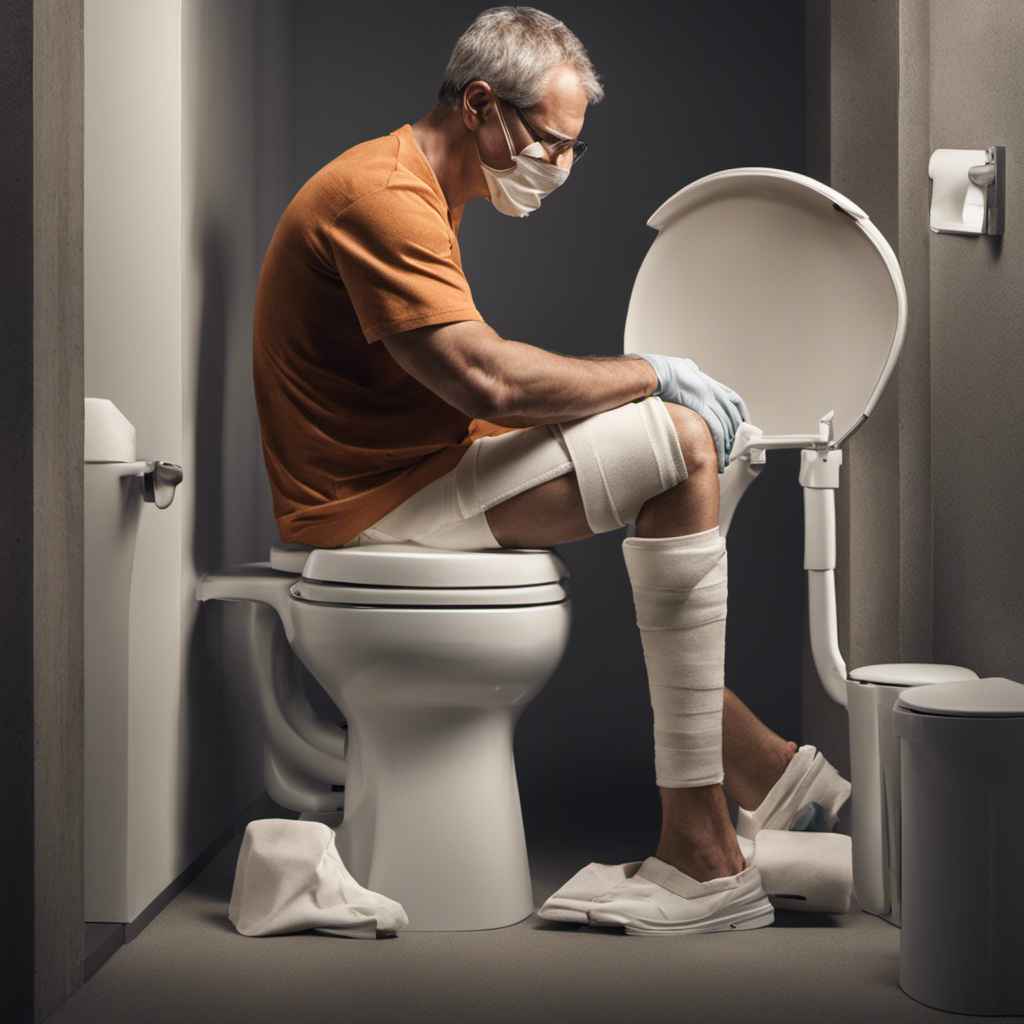I’ve been through knee surgery myself, and let me tell you, figuring out how to sit on the toilet afterwards can be quite a challenge! But fear not, because I’m here to guide you through the process.
In this article, you’ll learn how to prepare your bathroom, support your operated leg, choose the right toilet seat, and master the techniques for lowering yourself onto the toilet.
Rest assured, with these tips, you’ll be able to navigate this task with safety and comfort.
Key Takeaways
- Ensure enough space in the bathroom for easy navigation
- Use assistive devices like crutches, walker, or cane for support
- Select a raised toilet seat for easier sitting and standing
- Use a sturdy grab bar for support and maintain balance while lowering yourself onto the toilet
Preparing the Bathroom
Before you can sit on the toilet after knee surgery, you’ll need to prepare the bathroom. Ensuring bathroom accessibility and maintaining post-surgery hygiene are crucial for a smooth recovery.
First, make sure there is enough space in the bathroom to navigate with crutches or a walker. Clear any obstacles or rugs that may cause tripping hazards.
Install grab bars near the toilet for added stability and support. Place a raised toilet seat to minimize strain on your knee and make sitting down and standing up easier.
Additionally, keep the bathroom clean and well-stocked with essentials such as toilet paper, wipes, and hand sanitizer for proper post-surgery hygiene.
Supporting Your Operated Leg
During recovery, it’s important to make sure you’re properly supporting your leg after the operation. This will help promote healing and prevent further injury. Here are some tips on how to support your operated leg during this time:
-
Use assistive devices: Consider using crutches, a walker, or a cane to take some weight off your leg while sitting. These devices can provide stability and support.
-
Elevate your leg: When sitting on the toilet, try using a stool or a raised toilet seat to elevate your leg slightly. This will help reduce swelling and discomfort.
-
Use pillows or cushions: Place pillows or cushions on either side of your leg to provide additional support and prevent it from moving or bending in uncomfortable positions.
-
Take pain medication as prescribed: Managing pain and discomfort is crucial for a successful recovery. Follow your doctor’s instructions regarding pain medication to ensure you’re comfortable while sitting and during your daily activities.
Remember to consult with your healthcare provider for personalized advice and recommendations regarding your specific recovery needs.
Choosing the Right Toilet Seat
Selecting the appropriate toilet seat is crucial for ensuring comfort and support during recovery. After undergoing surgery, it is important to make certain modifications to your bathroom to accommodate your needs.
One of the key modifications is choosing the right toilet seat. There are several options available that can provide the necessary support and comfort. One option is a raised toilet seat, which elevates the seat height, making it easier to sit down and stand up.
Another option is a padded toilet seat, which offers additional cushioning for added comfort. Additionally, there are toilet seats with armrests that provide extra stability and support.
It is important to consider your specific needs and preferences when selecting a toilet seat, as it will greatly impact your post-surgery bathroom experience.
Techniques for Lowering Yourself Onto the Toilet
One helpful technique for easing yourself onto the toilet is to use a sturdy grab bar for support. This can provide stability and make the process safer and more comfortable.
Here are four additional techniques to ensure a smooth transition onto the toilet:
-
Proper posture: Sit on the edge of the seat and position your feet shoulder-width apart for better balance and stability.
-
Use assistive devices: Consider using a raised toilet seat or a commode chair with armrests to make it easier to lower yourself onto the toilet.
-
Use your upper body strength: Place your hands on the grab bar or armrests and slowly lower yourself down, using your arms to control the descent.
-
Take it slow: Lower yourself onto the toilet in a controlled manner, allowing your muscles and joints time to adjust.
Ensuring Safety and Comfort During the Process
By implementing these techniques, you can ensure a safe and comfortable experience when lowering yourself onto the toilet after having undergone knee surgery.
Maintaining hygiene is crucial during this process. Before sitting down, make sure to thoroughly wash your hands to prevent any potential infections.
Additionally, using assistive devices can greatly aid in maintaining stability and reducing strain on your knee. Consider using a raised toilet seat, which can provide a higher and more comfortable surface for sitting. A grab bar installed near the toilet can also provide additional support when lowering yourself onto the seat and standing up afterward.
These devices can help you maintain balance and prevent any accidental falls or injuries.
Conclusion
In conclusion, sitting on the toilet after knee surgery requires careful preparation and consideration.
By creating a safe and supportive environment in the bathroom, supporting your operated leg, choosing the right toilet seat, and using proper techniques to lower yourself onto the toilet, you can ensure both safety and comfort during this process.
Just as a skilled tightrope walker gracefully traverses the thin line between balance and uncertainty, so too can you navigate the delicate act of sitting on the toilet post-surgery with confidence and ease.
Remember, patience and mindfulness are key as you embark on this healing journey.










